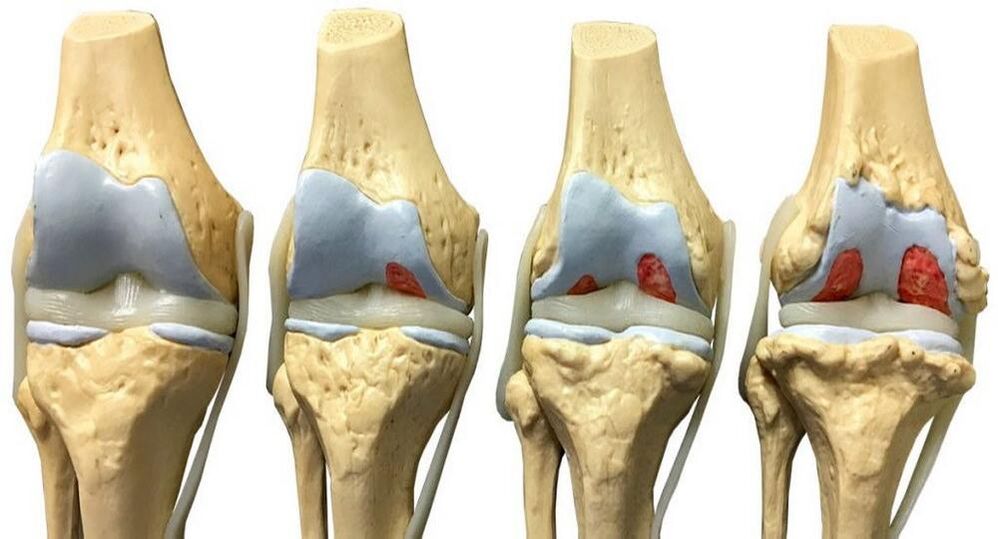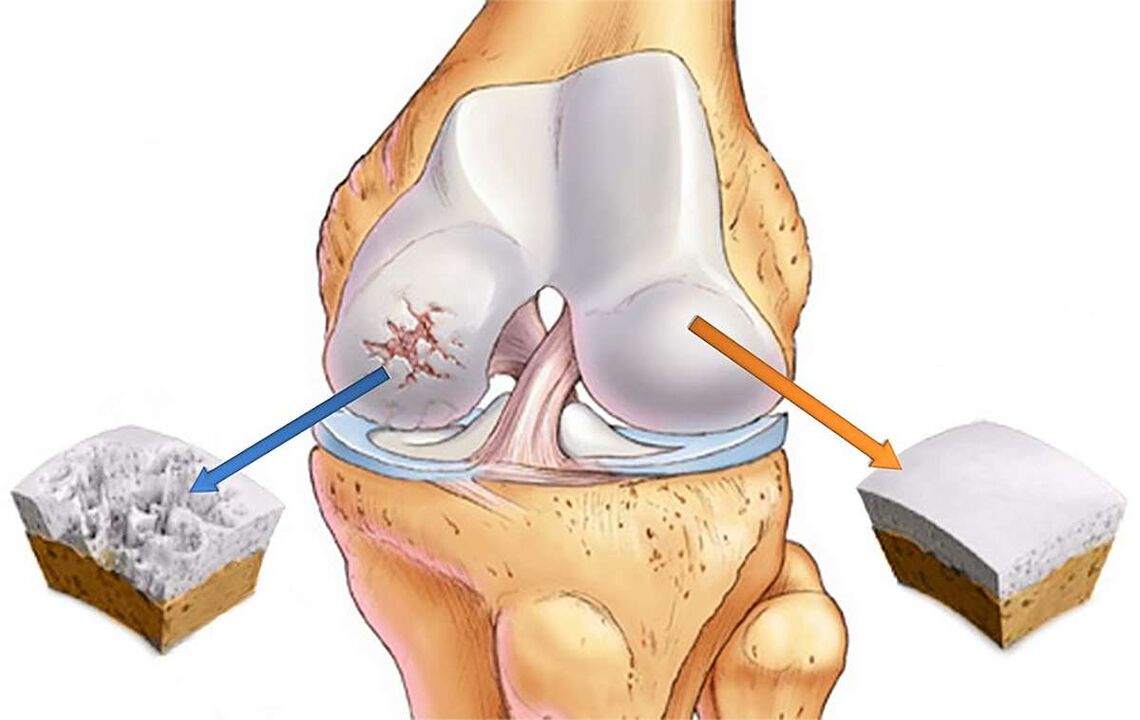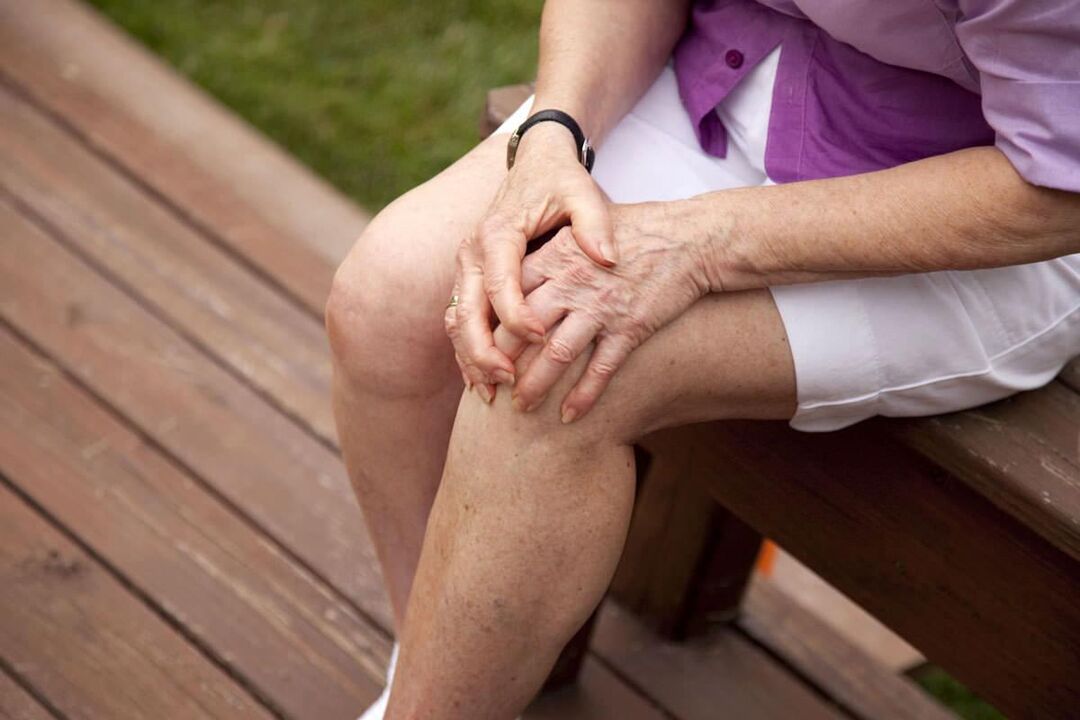Osteoarthritis of the knee joint means a reduction in the performance of the cartilage due to its curvature and destruction. Other terms are used to refer to this disease -osteoarthritis of the kneeanddeforming arthrosis. Currently, several methods of treating the disease are used: a specific option is selected taking into account the individual characteristics of the patient.
specificity of the disease
Osteoarthritis of the knee, as a rule, develops progressively. It usually occurs in women and older people who are overweight or have vein defects. The disease can occur on one or both knees at the same time.
The main stages of the development of arthrosis on the knee:
- initial. Due to the mutual friction of the cartilage and an increase in their roughness, the parameters of depreciation of the joint decrease. Sometimes cracking is observed.
- Second. At this stage, the bone begins to become covered with growths (osteophytes). On the inner surface of the articular bag, the curvature is fixed, stiffness is observed when working the limb. As a result, the knee joint gradually reduces its functionality. Due to the decrease in the thickness of the intercartilaginous lining, a decrease in the distance between the tibia and femur is observed.
- third partyIf nothing is done, the pain in the knee area will become permanent due to irreversible damage to the cartilage tissue. At this stage, the patient can no longer move normally.
The first symptoms of arthrosis of the knee joint are a sufficient reason to see a specialist. Otherwise there is a real risk of being unable to work.

Why osteoarthritis occurs
The main causes of the development of arthrosis of the knee joint:
- hereditary predisposition;
- temporary immobility of the knee joint as a result of injury;
- surgical removal of the meniscus;
- high physical activity, constant hypothermia;
- obesity, overweight problems;
- disruption of the ligaments (their weakening);
- other joint diseases (arthritis, swelling, various inflammations);
- failure of normal metabolism, lack of calcium in the body;
- flat feet (failure of center of gravity increases pressure on the joint);
- Stress, general fatigue, lack of sleep.
symptoms
Signs of probable osteoarthritis of the knee:
- pain in the knee joint. The pain appears suddenly against the background of physical exertion. In the first stage we are talking about a barely noticeable lumbago, later the disease becomes more serious.
- Visual violation of the shape of the knee. It happens in the later stages.
- Fluid accumulation, Baker's cyst. These are palpable seals at the back of the knee joint.
- The appearance of a crunch of cartilage against a background of sharp pain. This indicates the second or third stage of gonarthrosis.
- Inflammation of the inner region of the articular sac. It is manifested by edema and an increase in cartilage.
- Stiffness of the knee due to severe pain up to complete immobilization. This happens in the advanced stage of the disease.

treatment
Effective treatment of arthrosis of the knee joint is possible only with an integrated approach. Modern medicine is not yet able to offer a specific drug that can eliminate this disorder. The success of treatment procedures depends on the timeliness of identifying the problem, which allows you to start the fight against gonarthrosis at an early stage.
With the beginning of the treatment, the specialist pursues several goals:
- reduce pain symptoms as much as possible;
- to resume normal flow of nutrients to the joint;
- increase the intensity of blood circulation in the knee area;
- restoring the functionality of the supporting muscles in the problem area;
- make the knee as flexible as possible;
- Expand the space between the connected bones.
The exact treatment algorithm is determined individually. Distinguish between conservative and surgical techniques.
conservative method
This approach is used in the early stages of the onset of the disease and consists in the use of various drugs and therapeutic exercises.
Painkillers, anti-inflammatory drugs
To eliminate or relieve pain in the knee joint, the doctor usually prescribes the use of nonsteroidal anti-inflammatory drugs. In pharmacies they are represented by tablets, ointments and injections. Warming and anesthetic gels, ointments and patches show good effectiveness for pain relief.
A positive result in this case is usually obtained in 3-4 days. It should be understood that these medicines do not eliminate the disease, but only relieve pain. It is recommended to take painkillers only on the advice of a specialist and only when eliminating unbearable pain. The fact is that NSAIDs provoke the appearance of various side effects (especially the gastrointestinal tract suffers).
Hormonal drugs
In some cases, to relieve pain from osteoarthritis of the knee, the doctor may prescribe hormone injections. This approach is used when the effectiveness of NSAIDs is weak against the background of a progressive disease.
Hormones are prescribed for a short period (1-10 days) during exacerbations of osteoarthritis and fluid accumulation in the knee joint.
chondroprotectors
Restoration and nutrition of the cartilaginous layer at the beginning of the development of the disease, the so-called. Chondroprotectors (glucosamine, chondroitin sulfate). Glucosamine starts the process of cartilage regeneration, corrects metabolism, blocks destructive processes. Chondroitin sulfate disarms dangerous enzymes, increases the amount of collagen (this protein keeps cartilage hydrated). According to leading physicians, these drugs are currently showing the greatest positive effect in the treatment of gonarthrosis.
In particularly critical cases, when the cartilage tissue has serious abnormalities, chondroprotectors are ineffective. When prescribing glucosamine and chondroin sulfate, the doctor specifies specific daily doses. Only a systematic approach to taking these drugs gives a chance for positive results. On sale are tablets, capsules, injections, gels.
vasodilators
To eliminate spasms of the vascular system, to optimize blood circulation and metabolism in the knee area, the doctor prescribes means for vasodilation. As a rule, they are prescribed in combination with chondroprotectors. If, against the background of arthrosis, the fluid in the knee is not collected, it is allowed to rub the joint with a warming ointment and participate in therapeutic massage sessions.
hyaluronic acid
In its chemical composition, this substance is very close to the intra-articular fluid. After being introduced into the joint, the acid forms a film that protects the cartilage from mutual friction. It is allowed to use the drug after the end of the exacerbation.
therapeutic exercise
In the case of osteoarthritis of the knee orresort to exercise therapy, but only under the strict supervision of the attending physician or an experienced trainer. Self-medication is strictly prohibited, given the huge risks of careless movements and loads. Proper use of physiotherapeutic exercises will help keep the joint in working order, eliminate muscle spasms and relieve unpleasant symptoms. It is strictly forbidden to participate in physiotherapy exercises during exacerbations or in inappropriate conditions.
physical therapy
Proper use of physiotherapeutic techniques allows you to significantly reduce pain in the knee area, reduce inflammation and improve the flow of nutrients to the joint tissues. Before prescribing physical therapy, the orthopedist conducts a detailed diagnosis of the problem area, prescribes general and special tests, sends an ultrasound or x-ray. This allows you to get an up-to-date picture of the problem and choose the best methods.
The following types of physiotherapy have a good analgesic effect:
- UV irradiation. Due to exposure to ultraviolet rays, the sensitivity of the nerve endings decreases and pain is reduced. As a rule, it is prescribed in the later stages of the disease. The standard duration of treatment is 7-8 sessions.
- Local magnetic therapy. Improves the patient's overall health by reducing pain, inflammation and muscle spasms. Magnetic therapy is usually prescribed at the first fixation of the symptoms of knee arthrosis. The standard number of procedures is 20-25 sessions of 30 minutes each.
- Infrared laser therapy, UHF, SMW devices, ultrasound, therapeutic baths, etc.
If the disease has passed to the stage of dystrophic and deforming changes, the doctor recommends resort treatment. A specific list of procedures is compiled after a careful study of the patient's medical history.

surgery
This approach, if properly implemented, can partially or fully resume the work of the knee joint. The formation of the surgical intervention algorithm takes into account the degree of cartilage tissue destruction, the degree of inflammation, the amount of fluid collected, etc. As a rule, surgical intervention is performed in the late stages of gonarthrosis. This approach implies a fragmentary or complete replacement of the affected joint with an endoprosthesis.
The main approaches to surgical treatment:
- arthrodesis of the joint. During the operation, the surgeon fixes the leg in the most comfortable position for the patient, followed by immobilization of the knee joint. Defective cartilage is completely eliminated. Such a radical approach is relevant only in extreme cases.
- Arthroscopic debridement. It is used in the second stage of the development of knee arthrosis. Surgical removal of damaged cartilage tissue is performed, which allows you to save a person from pain for several years (usually 2-3 years).
- endoprosthetics. In this case, the knee joint or its separate part is replaced with a plastic, ceramic or metal implant that completely repeats the anatomical configuration of the natural joint. Endoprosthetics is now considered the most effective way to return a full-fledged lifestyle to a knee suffering from arthrosis for the next 15-20 years.
Competent planning and execution of the surgical treatment can improve the patient's well-being and restore (partial or full) mobility. At the same time, it should be understood that after the operation, a long period of recovery is required, participating in physiotherapy exercises, mechanotherapy, diet, etc.
rehabilitation
On average, the rehabilitation period after surgical treatment lasts 90 days:
The main tasks of rehabilitation:
- the patient's recovery of normal mobility;
- Optimizing the function of muscles and joints;
- Creation of a protective block for the prosthesis.
The drainage is removed 2-3 days after the operation, after which you can try to walk carefully. To relieve pain, the doctor prescribes drugs with a cooling effect. Small pain symptoms sometimes persist for a year after the operation: this is because the prosthesis needs time to heal. Elderly patients recover longer: to alleviate their condition, they are prescribed NSAIDs. In some situations, the attending physician prescribes hormonal agents that have a pronounced effect.
A week later, the patient enters the rehabilitation center under the care of an experienced physiotherapist. When developing exercise therapy, individual characteristics of the body are taken into account. Lessons take place regularly (daily), with gradually increasing loads: this protects against injuries and tissue tears.
period after discharge
At the end of the stay in the rehabilitation center, the patient is discharged and receives detailed recommendations for his future lifestyle. Dancing and light gymnastics are allowed after 6 months from the date of the operation. Heavy loads (fast running, jumping, sports games, heavy squats) must be completely excluded. Otherwise the prosthesis will quickly fail.
Do not lift heavy objects weighing more than 25 kg. Supporting handrails must be installed inside the apartment: they are placed on the stairs, in the shower room and in the bathroom. All furniture must be fully functional (especially chairs). These and other measures maximize the life of the prosthesis. You should also be prepared for postoperative arthrosis of the knee joint, which can last up to 3 years.
prevention of the onset of the disease
The best way to deal with any disease is to prevent it.
effective waysPrevention of osteoarthritis of the knee:
- Proper nutrition, maintaining a normal weight. It is better to avoid greasy and fried foods, alcohol, coffee, etc. An experienced nutritionist can give you detailed advice on this.
- Be mindful when exercising. It is desirable to reduce the load on the joints as much as possible.
- Watch out for diseases (especially infectious diseases), treat them properly and avoid chronic stages.
- Watch your posture, do not be careless with diseases of the bones and spine.
- Incorporate gentle physical activity into your daily routine (biking, swimming, hiking, joint strengthening exercises).
- Avoid self-treatment options for knee arthritis. At the first symptoms of the disease, you should immediately contact the clinic.
- Lead a calm lifestyle without stress and lack of sleep.
- Take measures to strengthen immunity (hardening, taking vitamins).
- Dress warmly in the cold season.
By applying the principles of a healthy lifestyle in your life and seeking medical help in a timely manner, you can minimize the risk of developing osteoarthritis of the knee joints. When choosing a clinic, preference should be given to proven treatment centers with modern equipment.




















